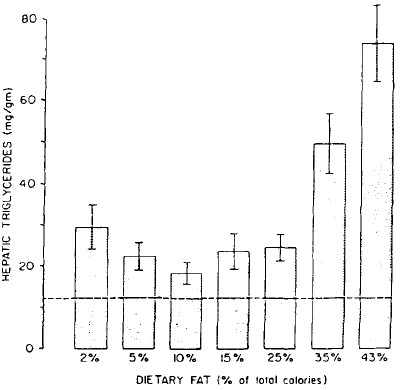TP4039:43%高脂型Lieber-DeCarli酒精液体模型饲料
Lieber-DeCarli Ethanol Liquid Diet(high fat
43%,TP4039)
一、43%高脂Lieber-DeCarli Alcohol Liquid Diet介绍
Lieber-DeCarli标准型(regular type)酒精液体饲料已经是高脂型(35%)。由于LD对饲料的分型是根据标准型定义的,43%脂肪热量的酒精液体饲料称为高脂肪型,而实际上属于超高型的酒精液体饲料。这种饲料的特点是极高脂肪和极低碳水化合物,其中,碳水化合物只有8.5%。
脂肪43%,蛋白质12.5%,碳水化合物8.5%, 酒精36%。
南通特洛菲饲料科技有限公司生产的该模型饲料的代码:TP4039;
【2】对照饲料:脂肪43%,蛋白质12.5%,碳水化合物44.3%。
南通特洛菲饲料科技有限公司生产的该对照饲料的代码:TP4039C;
二、TP4039高脂型Lieber-DeCarli ethanol liquid diet的用途

Effect of varying amounts of dietary fat on hepatic fat accumulation produced by ethanol. Hepatic triglycerides were measured in seven groups of rats given ethanol (36% of calories) with a diet of normal protein) content. Average hepatic triglyceride concentration in the control animals is indicated by a dotted line.
该饲料由于脂肪含量极高而碳水化合物含量极低,一般可用于:
1. 酒精性脂肪肝造模及相关机制的研究。
将TP4039用于酒精性脂肪肝造模时,肝脏脂肪沉积非常严重(见右图中右起第一个bar,是正常的7-8倍),而标准型引起的肝脏沉积是正常的5倍。要特别注意的是,应当优先使用TP4030(标准型),这是因为TP4039中脂肪过高、碳水化合物过低,形成的是酮体代谢和酒精的联合作用。
由于4.9%极低脂肪液体饲料胃管灌注(IEI法)能够模拟43%高脂液体饲料喂养所致的脂肪肝,研究者认为,43%高脂液体饲料所致酒精性脂肪肝应该是由于饲料所致肝内甘油三酯的合成过多而不是源于饲料脂肪进入血液后在肝脏的沉积。
2. 酮体与酒精的相互作用。
3. 观察脂肪不同含量时酒精效应的比较,TP4039作为高脂、低碳水化合物使用。
三、TP4039选购和使用的注意点
TP4039是酒精热量为36%、蛋白质热量12.%、碳水化合物热量8.5%的液体饲料。如果希望降低酒精热量并且提高蛋白质热量的低碳水化合物酒精液体饲料,可以选用TP4060(Lindros酒精液体饲料),该饲料是脂肪44%, 蛋白质16%, 碳水化合物5.5%, 酒精34.5%。
关于Lieber-DeCarli酒精液体模型饲料的详细介绍,请点击“Lieber-DeCarli酒精液体饲料和注意事项”。
请特别注意:购买后应当及时向公司索取以下资料:
《液体饲料配制方法》
《酒精液体饲料喂养方法》
《怎样根据研究的需要调整酒精的配比》
References:
D'Souza El-Guindy NB, Kovacs EJ, De Witte P, Spies C, Littleton JM, de Villiers WJ, Lott AJ, Plackett TP, Lanzke N, Meadows GG. Laboratory models available to study alcohol-induced organ damage and immune variations: choosing the appropriate model. Alcohol Clin Exp Res. 2010 Sep 1;34(9):1489-511.
Phytother Res. 2009 Apr;23(4):525-32. doi: 10.1002/ptr.2665. Trans-resveratrol alone and hydroxystilbenes of rhubarb (Rheum rhaponticum L.) root reduce liver damage induced by chronic ethanol administration: a comparative study in mice. Raal A, Pokk P, Arend A, Aunapuu M, Jõgi J, Okva K, Püssa T.
Siegmund SV, Haas S, Singer MV. Animal models and their results in gastrointestinal alcohol research. Dig Dis. 2005;23(3-4):181-94.
Tsukamoto H, Lew G, Larkin EC, Largman C, Rao GA. Hepatic origin of triglycerides in fatty livers produced by the continuous intragastric infusion of an ethanol diet. Lipids. 1984 Jun;19(6):419-22.
Lieber CS, DeCarli LM. The feeding of alcohol in liquid diets: two decades of applications and 1982 update. Alcohol Clin Exp Res. 1982 Fall;6(4):523-31.
Lieber CS, Jones DP, Decarli LM. Effects of prolonged ethanolo intake: Production of fatty liver despite adequate diet. J Clin Invest. 1965 Jun;44:1009-21.
Inhibition of the chronic ethanol-induced fatty liver by antioxidant administration. Hartman AD, Di Luzio NR. Proc Soc Exp Biol Med. 1968 Jan;127(1):270-6.
---------《》-------
 可以任意缺乏或过载某营养素
可以任意缺乏或过载某营养素
 可以任意添加药物或测试成分
可以任意添加药物或测试成分
 可以精确定量饲料摄入量
可以精确定量饲料摄入量
 可以任意定制饲料
可以任意定制饲料
- AIN76酒精液体饲料(TP4000)
- AIN93G酒精液体饲料(TP4010)
- AIN93M酒精液体饲料(TP4020)
- 标准型Lieber-DeCarli酒精液体饲料(TP4030)
- 43%高脂肪型Lieber-DeCarli酒精液体饲料(TP4039)
- 12%低脂型Lieber-DeCarli酒精液体饲料(TP4032)
- 10%低脂肪型Lieber-DeCarli酒精液体饲料(TP4031)
- 5%低脂型Lieber-DeCarli酒精液体饲料(TP4033)
- 2%低脂型Lieber-DeCarli酒精液体饲料(TP4034)
- 25%高蛋白型Lieber-DeCarli酒精液体饲料(TP4035)
- 12.5%低蛋白型Lieber-DeCarli酒精液体饲料(TP4036)
- 4%低蛋白型Lieber-DeCarli酒精液体饲料(TP4038)
- 2%低蛋白型Lieber-DeCarli酒精液体饲料(TP4037)
- 26%酒精Rao-Larkin酒精液体饲料(TP4063)
- 40%酒精高脂Nanji液体饲料(TP4054)
- 29%酒精高脂Nanji液体饲料(TP4062)
- Lindros酒精液体饲料(TP4060)
- Lieber-DeCarli酒精液体饲料25%高蛋白型
- Weinberg-Keiver酒精液体饲料(TP4040)
- Yeh-Cerklewski酒精液体饲料(TP4100)
- Sahchis酒精液体饲料(TP4230)
- Wiener酒精液体饲料(TP4200)
- Tsukamoto-French模型酒精液体饲料
- Thompson-Reitz酒精液体模型饲料(TP5100)
- Badger酒精液体饲料
- 微型猪(小型猪)酒精液体饲料
- 灵长类Lieber-DeCarli酒精液体饲料(TP7000)
